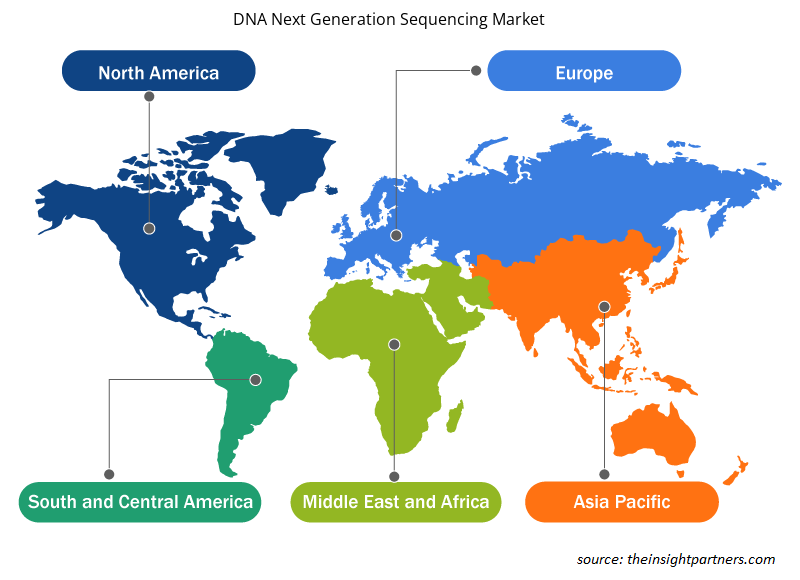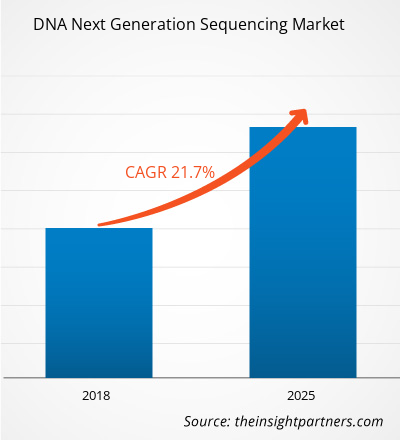[Research Report] The DNA next generation sequencing market size is estimated to reach US$ 22,716.9 million by 2025 from US$ 4,898.5 million in 2017; it is expected to grow at a CAGR of 21.7% during 2018-2025.
Next generation sequencing is also known as high-throughput sequencing. NGS enables rapid sequencing of the base pairs in DNA samples. NGS is driving the drug discovery application and enabling the future of personalized medicine, genetic diseases, and clinical diagnostics. Moreover, next-generation sequencing (NGS) is a massively parallel sequencing technology that can establish the order of nucleotides in a whole genome with scalability, ultra-high throughput, and fast speed. Since it includes preparing the sample for the subsequent sequencing reaction, DNA pre-sequencing is one of the most important processes in the total sequencing protocol. In the global healthcare sector, NGS is steadily being integrated into clinical laboratory analysis, testing, and disease diagnoses. In pharmacogenomics, NGS has been widely employed to speed up the drug discovery process.
The DNA next generation sequencing market growth is attributed owing to increasing number of cancer cases across the globe, rising research studies, increasing collaborations between research institutes and market players along with rising applications of DNA next generation sequencing and technological advancements in sequencing technologies. However, the dearth of skilled professionals is expected to critically impact the overall DNA next generation sequencing market growth.
Customize This Report To Suit Your Requirement
You will get customization on any report - free of charge - including parts of this report, or country-level analysis, Excel Data pack, as well as avail great offers and discounts for start-ups & universities
DNA Next Generation Sequencing Market: Strategic Insights

- Get Top Key Market Trends of this report.This FREE sample will include data analysis, ranging from market trends to estimates and forecasts.
Customize This Report To Suit Your Requirement
You will get customization on any report - free of charge - including parts of this report, or country-level analysis, Excel Data pack, as well as avail great offers and discounts for start-ups & universities
DNA Next Generation Sequencing Market: Strategic Insights

- Get Top Key Market Trends of this report.This FREE sample will include data analysis, ranging from market trends to estimates and forecasts.
Market Insights
Declining Price of Sequencing and Technological Advancements in Sequencing Methods Drives DNA Next Generation Sequencing Market
In the recent years, next generation sequencing prices have declined substantially. In 2000, the cost for sequencing human genome was US$ 3.7 billion and took 13 years for completion. However, the costs for the same in recent years reduced to US$ 10 million in 2006 and further declined in 2012, and the process requires fewer days. Major DNA next generation sequencing market players such as Illumina and Roche have introduced breakthrough technologies that are cost-efficient and require less time in sequencing processes.
Moreover, advancement in the field of molecular biology has equally enhanced sequencing procedures. Many industry players have come up with innovative NGS technology in the last few years. For instance, Pacific Biosciences with Sequel and Oxford Nanopore with PromethION. Additionally, three advanced NSG systems that dominate the market include Roche GS FLX (454), Illumina HiSeq 2000 (Solexa), and AB SOLiD (Agencourt).
Further modification and automation of this process continued to increase sequencing data and also resulted in managing time more efficiently, thereby allowing researchers to reach major milestones in the Human Genome Project. NGS makes sequence-based gene expression analysis a “digital” alternative to analog techniques. Advancement in genome sequencing has made sequencing easy and accurate. These technological advancements are likely to boost the DNA next generation sequencing market size in the near future.
Product-Based Insights
The global DNA next generation sequencing market, based on product, is segmented into platforms, services, and consumables. The platform segment is further sub-segmented into HiSeq Series, MiSeq Series, SOLiD, Ion Torrent, Pacbio Rs II and Sequel Systems, and others. Further, the services segment is sub-segmented into sequencing services and data management and analysis services. Moreover, the consumables segment is sub-segmented into sample consumable preparation and other NGS consumables. The consumables segment held a larger share among the product subsegments in the DNA next generation sequencing market in 2017 and is also anticipated to follow a similar trend over the forecast period. More recent NGS platforms have adopted a new sequencing method, called single-molecule sequencing (SMS), which does not require prior amplification of DNA, thus avoiding the PCR-related error reads or amplification bias toward repeat regions. During the past five years, next-generation sequencing (NGS) has transitioned from research to clinical use. At least 14 countries have created initiatives to sequence large populations, and it is projected that more than 60 million people worldwide will have their genome sequenced by 2025.
Application-Based Insights
The global DNA next generation sequencing market, based on application, is segmented into diagnostics, drug discovery, precision medicine, and other applications. The diagnostics segment held the largest share in 2017 and is expected to witness significant growth over the next five to six years. The use of next-generation sequencing (NGS) technology in diagnostic genome care needs precision and accuracy. The NGS technologies use cost-efficient sequencing to gain genomic information about the patients from the whole-genome sequencing to perform clinical actions. Next-generation sequencing is eventually substituting conventional technologies to diagnose various genetic disorders. Large sets of genes can now be addressed in a single test instead of a gene-by-gene approach.
End User-Based Insights
The global market, based on end user, is segmented into academic & research institutes, pharmaceutical & biotechnology companies, hospitals & clinics, and other end users. The academic and research institutes segment is expected to witness the highest growth over the forecast period. The sequence helps scientists in finding the kind of genetic information that is carried in a particular DNA segment. For example, scientists can use sequence information to determine which stretches of DNA contain genes and which stretches carry regulatory instructions, turning genes on or off. The automated-industrialized approach based on random or shotgun sequencing was introduced by The Institute for Genomic Research (TIGR) in Rockville, Maryland, and resulted in the publication of 337 new human genes and 48 homologous genes from other organisms
DNA Next Generation Sequencing Market Regional Insights
The regional trends and factors influencing the DNA Next Generation Sequencing Market throughout the forecast period have been thoroughly explained by the analysts at Insight Partners. This section also discusses DNA Next Generation Sequencing Market segments and geography across North America, Europe, Asia Pacific, Middle East and Africa, and South and Central America.

- Get the Regional Specific Data for DNA Next Generation Sequencing Market
DNA Next Generation Sequencing Market Report Scope
| Report Attribute | Details |
|---|---|
| Market size in 2017 | US$ 4.9 Billion |
| Market Size by 2025 | US$ 22.72 Billion |
| Global CAGR (2017 - 2025) | 21.7% |
| Historical Data | 2015-2016 |
| Forecast period | 2018-2025 |
| Segments Covered |
By Product
|
| Regions and Countries Covered | North America
|
| Market leaders and key company profiles |
DNA Next Generation Sequencing Market Players Density: Understanding Its Impact on Business Dynamics
The DNA Next Generation Sequencing Market market is growing rapidly, driven by increasing end-user demand due to factors such as evolving consumer preferences, technological advancements, and greater awareness of the product's benefits. As demand rises, businesses are expanding their offerings, innovating to meet consumer needs, and capitalizing on emerging trends, which further fuels market growth.
Market players density refers to the distribution of firms or companies operating within a particular market or industry. It indicates how many competitors (market players) are present in a given market space relative to its size or total market value.
Major Companies operating in the DNA Next Generation Sequencing Market are:
- Illumina, Inc.
- Thermo Fisher
- Qiagen N.V.
- Beijing Genomics Institute
- PerkinElmer, Inc.
Disclaimer: The companies listed above are not ranked in any particular order.

- Get the DNA Next Generation Sequencing Market top key players overview
Product launches and approvals are commonly adopted strategies by companies to expand their global footprints and product portfolios. Moreover, the market players focus on the partnership strategy to enlarge their clientele, which, in turn, permits them to maintain their brand name across the world. The market share is anticipated to flourish with the development of new innovative products by market players. Some of the market participants present in the concerned market are THERMO FISHER SCIENTIFIC INC.; Illumina, Inc; Qiagen N.V.; Beijing Genomics Institute; PerkinElmer, Inc.; F.Hoffman-La Roche Ltd.; Agilent Technologies; Eurofins Scientific; Oxford Nanopore Technologies Ltd; and Macrogen Inc.
- Historical Analysis (2 Years), Base Year, Forecast (7 Years) with CAGR
- PEST and SWOT Analysis
- Market Size Value / Volume - Global, Regional, Country
- Industry and Competitive Landscape
- Excel Dataset


- Photo Printing Market
- Animal Genetics Market
- Gas Engine Market
- Wheat Protein Market
- Procedure Trays Market
- Dealer Management System Market
- Public Key Infrastructure Market
- Artificial Intelligence in Healthcare Diagnosis Market
- Artificial Intelligence in Defense Market
- Analog-to-Digital Converter Market

Report Coverage
Revenue forecast, Company Analysis, Industry landscape, Growth factors, and Trends

Segment Covered
Product, Application, End User, and Geography

Regional Scope
North America, Europe, Asia Pacific, Middle East & Africa, South & Central America

Country Scope
US, Canada, Mexico, UK, Germany, Spain, Italy, France, India, China, Japan, South Korea, Australia, UAE, Saudi Arabia, South Africa, Brazil, Argentina
Frequently Asked Questions
The DNA next generation sequencing market is growing at CAGR of 21.7% from 2018-2025.
Major market players such as Illumina and Roche have introduced breakthrough technologies that have enabled in the cost and time reduction in the sequencing.
As per forecast report, the market value of DNA next generation sequencing market in 2025 will be US$ 22,716.9 Million.
The growth of the global DNA next generation sequencing market is attributed to the increases in cancer prevalence, technological development and decreasing price of sequencing. Owing to factors like advances within the field of genetic science, development in several ways and methods for sequencing, there's a notable decline within the price of sequencing.
Trends and growth analysis reports related to Life Sciences : READ MORE..
The List of Companies
1. Illumina, Inc.
2. Thermo Fisher
3. Qiagen N.V.
4. Beijing Genomics Institute
5. PerkinElmer, Inc.
6. Hoffman-La Roche Ltd.
7. Agilent Technologies
8. Eurofins Scientific
9. Oxford Nanopore Technologies Ltd.
10. Macrogen Inc.

 Get Free Sample For
Get Free Sample For